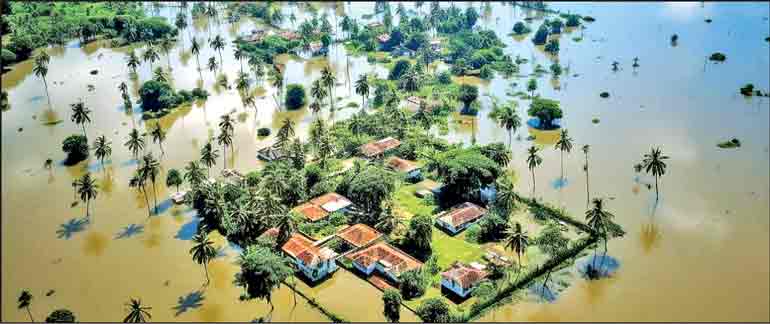Monday Nov 03, 2025
Monday Nov 03, 2025
Saturday, 28 October 2023 00:25 - - {{hitsCtrl.values.hits}}

There is an urgent need to scale up finance for addressing climate-induced loss and damage, especially in climate-vulnerable developing countries such as Sri Lanka
 With the impacts of climate change intensifying at a rapid pace, climate-induced loss and damage presents a critical challenge for countries across the world. There is an urgent need to scale up finance for addressing climate impacts and supporting those who are on the frontlines, especially in climate-vulnerable developing countries such as Sri Lanka.
With the impacts of climate change intensifying at a rapid pace, climate-induced loss and damage presents a critical challenge for countries across the world. There is an urgent need to scale up finance for addressing climate impacts and supporting those who are on the frontlines, especially in climate-vulnerable developing countries such as Sri Lanka.
In this context, the loss and damage fund established under the United Nations Framework Convention on Climate Change (UNFCCC) in late 2022 could play a pivotal role. The fund is meant to provide finance to nations grappling with the adverse impacts of climate change and address the existing financial gaps for building long-term climate resilience. After the 27th meeting of the Conference of Parties (COP27), the fund is currently being operationalised through the work of a Transitional Committee, which has met four times throughout 2023 to lay the groundwork for a decision at COP28 in November/December this year.
Financing loss and damage
The term “loss and damage” (L&D) covers those climate impacts that go beyond the limits of adaptation and cannot be (or have not been) averted through emission reduction or adaptation efforts. Addressing such impacts requires a multi-faceted approach that combines finance as well as other means of implementation, such as technology and institutional capacity-building. Finance is the linchpin that enables the implementation of concrete measures to address L&D, including early warning systems, climate insurance, risk pooling, resilient infrastructure, relief, rehabilitation, and recovery.
Establishing a dedicated global fund for L&D presents an important milestone in supporting vulnerable countries and providing them with the necessary funding to engage in these actions. However, the fund needs to navigate the complex terrain of climate-induced challenges, ranging from infrastructural damage to livelihood disruptions, as well as challenges related to its operationalisation and finding agreement between developed and developing countries.
The basic building blocks of a loss and damage fund consist of its sources of funding; its organisational structure and secretariat; the scope and modalities of funding, including potential funding windows or categories; eligibility to receive funding; approaches to addressing different kinds of L&D; international cooperation; and reporting and oversight mechanisms to ensure the transparent, equitable, and accountable operation of the fund.
While adequate capitalisation and sustained funding are essential to ensure that the fund can provide meaningful support, there are also other important considerations as well. These include, for example, climate justice and inclusive processes; the principle of common but differentiated responsibilities and respective capabilities, which is embedded in the UNFCCC to acknowledge the different capabilities and responsibilities of individual countries for climate action; and ensuring that cross-cutting vulnerabilities and aspects are acknowledged and addressed, such as gender, youth, Indigenous peoples, and particularly vulnerable countries.
The meetings of the Transitional Committee have provided a space for countries to discuss these questions and find alignment that could lead towards a decision at COP28. As mandated during COP27, the Transitional Committee has been established to provide recommendations on the fund’s building blocks and operationalisation, including its place within the wider global financial architecture and the mobilisation of new and innovative sources of funding.
COP28 as a milestone for loss and damage finance
From 30 November till 12 December 2023, the parties to the UNFCCC and the Paris Agreement will meet in Dubai for the annual global climate change conference and climate negotiations. As in COP27 last year, L&D will be high on the agenda, with multiple workstreams that are relevant to this thematic area: the L&D fund, the Santiago Network, the Warsaw International Mechanism, and the Global Stocktake, among others.
For the L&D fund, the recommendations of the transitional committee will be considered for adoption when parties formulate a decision on L&D finance and funding arrangements. COP28 presents an opportunity to reflect, refine, and ratify the operational modalities of the fund, as well as to ensure that it adheres to key principles of climate justice and inclusiveness. Moreover, the conference also provides a platform for vulnerable countries to articulate their needs and for the global community to reaffirm its commitment to provide tangible support.
The discussion around L&D consists of a multitude of different aspects and focus areas, including climate justice, the principle of common but differentiated responsibilities, and global cooperation. Without adequate financial resources, climate-vulnerable developing countries such as Sri Lanka may struggle to effectively address climate-induced L&D. Financial support from the international community, including through a loss and damage fund under the UNFCCC, is crucial to enable comprehensive action, build long-term resilience, and support sustainable development in the face of climate change.
(The writer works as Director: Research and Knowledge Management at SLYCAN Trust, a non-profit think tank based in Sri Lanka. His work focuses on climate change, adaptation, resilience, ecosystem conservation, just transition, human mobility, and a range of related issues. He holds a Master’s degree in Education from the University of Cologne, Germany and is a regular writer to several international and local media outlets.)